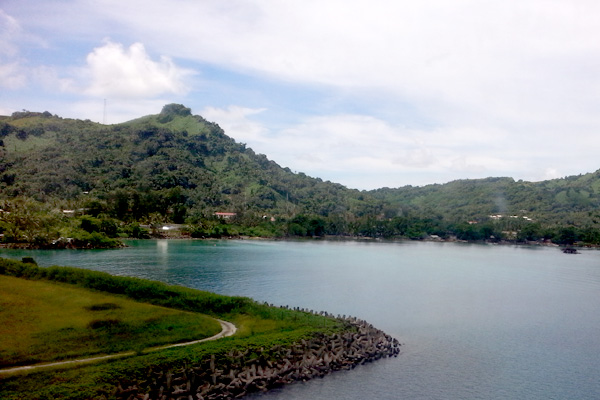
The varied elevations typical of small islands such as Chuuk in the Federated States of Micronesia add complications such as landslides to existing natural vulnerabilities. © Joe Lowry/IOM 2014
By Ashley Carl, IOM Chief of Mission in the Federated States of Micronesia
The government of the Federated States of Micronesia (FSM) is spearheading efforts to address the impacts of climate change and disaster risk in the country. In pursuit of a safe, resilient and sustainable future for the country, the FSM government (with support from the European Union and the Secretariat of the Pacific Community) developed a nationwide Disaster Risk Management and Climate Change Policy in June 2013. The main objective of this policy is to mainstream climate change and disaster risk through the sustainable development strategy.
Micronesia, like other Pacific regions, is extremely vulnerable to climate change and natural hazards. Recent climate projections have indicated that climate change is likely to increase the intensity and frequency of some climate-related hazards in the region, including extreme temperatures, sea-level rise and extreme rainfall events. These can in turn lead to secondary hazards, such as landslides.
For several years IOM in Micronesia has been developing contingency plans for the delivery of humanitarian assistance following natural disasters. The recent severe drought in the neighbouring Marshall Islands, which affected approximately 13% of the population, was a wakeup call for countries in this remote region of the urgency of reducing the risks of disasters and adapting to climate change.
The adoption of the policy by the FSM Congress was a progressive initiative and the incorporation of human mobility in policy formulation highlighted the recognition of environmental migration. With IOM’s assistance, the FSM Office of Environment and Emergency Management (OEEM) successfully mainstreamed environmental migration in the text of the policy document. The FSM now reciognises “the rights of island communities to their ancestral lands, while also acknowledging the role that migration has played, and will continue to play, as an adaptation strategy to a changing environment.”
Through adaptation strategies, the Government is attempting to prevent forced migration resulting from environmental degradation; however, it acknowledges the importance of managing human mobility in an orderly and humane manner in a changing environment. This is particularly important to the remote outer island communities, which face increasing threats from extreme natural events and climate change.
The incorporation of environmental migration into a disaster risk management and climate change policy does not always receive such consideration. When managing disaster risks and developing strategies for climate change adaptation, policy-makers balance a number of priorities ranging from economic resilience to food, water and energy security.
It was through the regular coordination of community-based disaster risk reduction and climate change adaptation activities that OEEM and IOM were able to commence planning for the management of displaced populations; particularly following climate-induced natural hazards. One of the primary aims of IOM’s collaboration with the Government is to ensure that environmental migration is managed with appropriate safeguards for the protection of displaced populations.